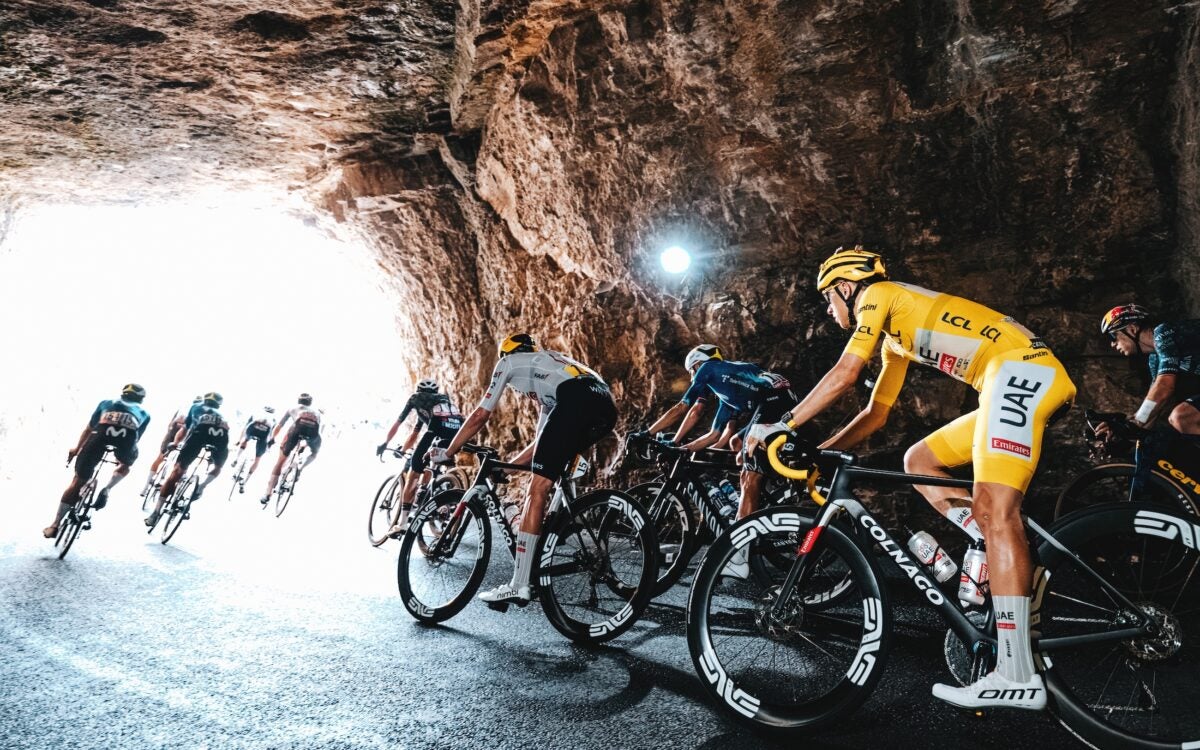“], “filter”: { “nextExceptions”: “img, blockquote, div”, “nextContainsExceptions”: “img, blockquote, a.btn, a.o-button”} }”>
“Blood flow restriction” isn’t only a search term that might appear on the dark web.
It’s a powerful performance enhancer, too.
“Restricting blood flow when working at low intensity creates the same environment in a muscle as that which exists when training at high intensity,” said Tudor Pro Cycling trainer James Spragg.
“It’s been shown that if you restrict blood during an exercise, you can do 30 percent of a one rep max, and it gives a similar outcome as doing a one rep max exercise,” Spragg told Velo.
“That’s why BFR is seen as having huge potential for performance.”
Blood flow restriction [“BFR”] involves strapping a sort of sporting tourniquet to a working muscle.
Slowing down blood supply “traps” nutrients in already-stressed cells to create a massive metabolic boost.
The practice was born decades ago in the murk of the weights room and has more recently escaped into the world of endurance.
Since then, athletes recovering from injury have been using it to lift light but get outsize gains, whether they’re bench press champions, Tour de France contenders, or 2:05 marathoners.
More recently, BFR has been pitched as a powerful – albeit risky – active training tool, too.
“The evidence is very, very good that it has benefits for endurance performance,” said Richard Ferguson, lead BFR researcher and reader in human and exercise physiology at Loughborough University. “It’s a no-brainer.
“It ‘tricks’ the muscle into thinking it’s exercising hard. All the metabolic byproducts are trapped in the muscle, so that creates a boosted physiological response,” Ferguson told Velo.
“So if you combine low-intensity work with blood flow restriction, the muscle feels like it’s working really, really hard.”
The Atlanta Falcons are always chasing peak performance, and now they’re using Hytro’s Blood Flow Restriction (BFR) tech to boost recovery like never before.
See behind-the-scenes on YouTube: https://t.co/GGyVToJkHU
⁰#HytroBFR #NFLPerformance #AtlantaFalcons #BFRTraining pic.twitter.com/c66gO0iiai— Hytro (@Hytrotraining) April 23, 2025
Yet intriguingly, the peloton’s use of BFR doesn’t always match the science.
This age-old strength training protocol is still something of a mystery to the high-precision world of bike racing.
Bringing blood flow restriction cuffs to the team bus
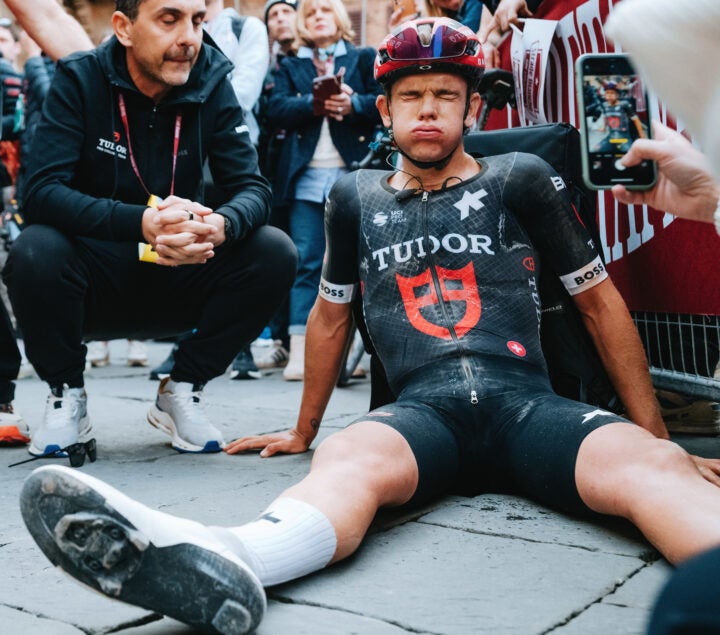 Tudor Pro Cycling is bringing BFR in its recovery protocols. (Photo: Gruber Images/Velo)
Tudor Pro Cycling is bringing BFR in its recovery protocols. (Photo: Gruber Images/Velo)
Almost every top-level team will have tinkered with BFR in some capacity.
Riders can use the practice to preserve muscle mass while stuck on the sidelines with a bone or soft-tissue injury.
When blood-restricted, a low-intensity workout creates a physiological pump that won’t strain damaged tendons or stress fragile fracture sites.
At present, most riders will encounter a restriction cuff in this context of the rehab room.
They’re now increasingly finding them in their team buses and hotel rooms, too.
BFR is becoming a passive recovery tool that staffers accept might be no more than an uncomfortable placebo.
“The hypothesis behind it is that nutrient delivery can be really targeted, because you’ve got targeted blood flow to exactly where you want to deliver nutrients,” said Tudor training guru Spragg.
“We’ve seen in clinical and sporting populations that BFR can reduce muscle soreness and increase pain thresholds for around 24 hours,” Spragg said. “This all remains unproven, though.”
Quick-Step, Tudor team up with specialist BFR supplier
 Hytro BFR boasts partnerships with Quick-Step and Tudor as well as soccer, Formula 1, and NFL. (Photo: Courtesy: Hytro)
Hytro BFR boasts partnerships with Quick-Step and Tudor as well as soccer, Formula 1, and NFL. (Photo: Courtesy: Hytro)
Soudal Quick-Step and Spragg’s Tudor Pro Cycling team recently partnered with the brand Hytro for specialized blood flow restriction products.
Hytro also boasts high-profile relationships with teams in the NBA, NFL, Premier League, and Formula 1.
The brand makes shorts and T-shirts with integrated cuffs that have been approved as safe for use without professional guidance. Until recently, BFR was typically confined to environments under careful supervision.
This super-caution is perhaps no surprise given the results of a recent study into BFR.
Associated risks include “numbness, nausea, hypertension, headache, venous thrombus, deterioration of ischemic heart disease, fainting, tingling, excessive pain, central retinal vein occlusion, and rhabdomyolysis.”
Nottingham Forest have incorporated Blood Flow Restriction (BFR) training into their recovery sessions this season, tapping into the latest sport science.
BFR accelerates recovery by enhancing muscle repair, reducing joint strain, and promoting muscle growth with lighter… pic.twitter.com/2dAunksST2
— Keepitonthedeck (@Keepitonthedeck) February 7, 2025
Soudal Quick-Step physiotherapist Manu Wemel explained to Velo how he has riders use Hytro for three intervals of five minutes during the copious dead-time around races.
Remco Evenepoel’s “Wolf Pack” strap up their thighs, load up Netflix, and reap a “benefit” that’s so far anecdotal at best.
“When they come on the bus after a race, they use the cuffs before or immediately after they shower,” Wemel told Velo. “It only takes 20 minutes, and they can do it while they’re eating or sitting and relaxing.
“A lot of riders are a bit unsure about it so far. Uptake has been very mixed – some think it’s uncomfortable,” Wemel continued. “We let them all choose their recovery strategy – it’s not enforced.”
A ‘no downside’ addition to the recovery toolkit
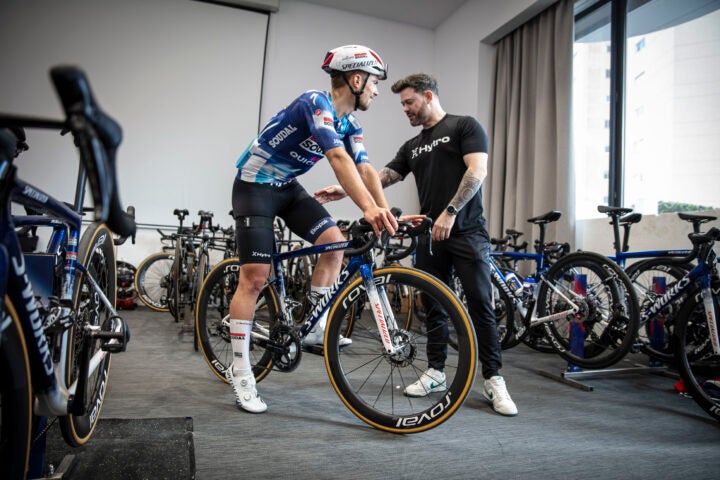 Soudal Quick-Step and Tudor Pro Cycling is partnering Hytro for BFR products (see shorts). (Photo: Courtesy Soudal Quick-Step/Hytro)
Soudal Quick-Step and Tudor Pro Cycling is partnering Hytro for BFR products (see shorts). (Photo: Courtesy Soudal Quick-Step/Hytro)
Tudor staffer Spragg acknowledged there’s little science to back blood flow restriction for passive recovery. Lead BFR academic Ferguson told Velo he’s extremely sceptical of the application.
It’s unusual for the science-powered, evidence-based peloton to tinker with any unproven practice.
But like compression socks, massage, and other semi-proven recovery protocol … why not?
“The potential negative impacts of BFR for recovery are minimal. And if we encounter a negative reaction with a rider, we can stop straight away, really easily,” Spragg said.
For Spragg, if BFR gives riders even a quarter-percentage boost when they can otherwise only scarf rice and scroll social media, it’s a success.
“We use BFR at times where riders can’t do a lot more, like in a bus transfer. If we can add something at a point in time that has potential upsides and very few potential downsides, and the riders feel the benefit, that’s a win,” he said.
“Many riders feel a benefit from it – if they can reduce the sensation of sore and tired legs, they’re happy.”
The next frontier?
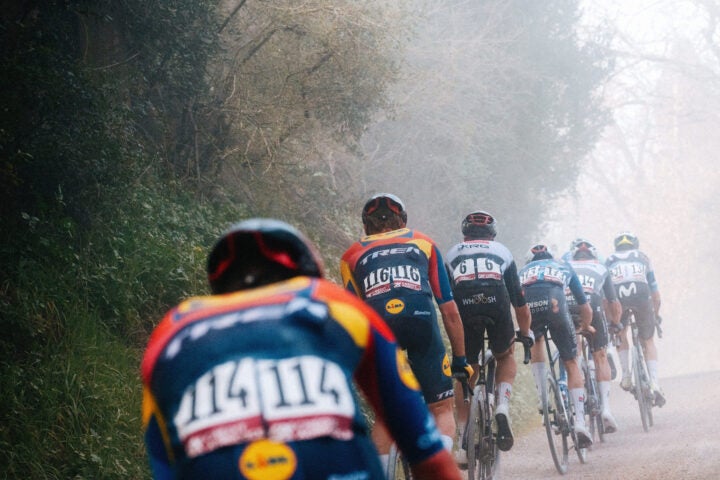 Will BFR break into the world of active training? (Photo: Gruber Images/Velo)
Will BFR break into the world of active training? (Photo: Gruber Images/Velo)
The recovery and rehab application of blood flow restriction isn’t the sexiest, most progressive method in modern cycling.
However, the potential of using BFR for a blood-restricted training boost could be.
The power of blood flow restriction for performance hasn’t escaped the notice of an elite endurance community on an endless quest for “marginal” gains.
“The adaptive potential is really strong for components of endurance; things like VO2 max, lactate thresholds, and other physiological thresholds,” university researcher Ferguson said.
“It’s underpinned by how it impacts the number of capillaries and the mitochondria – the energy components of the muscle that are important for endurance performance.”
The science behind BFR makes it potentially the best athletic cheat code since “accidentally” losing 10kg when racing on Zwift.
Spragg explained how pushing 150 watts at the pedals could bring a physiological response equivalent to, for example, 450 watts. Using a cuff under effort could bring a humble weekend warrior a Pogačar-level physiological response.
Alternatively, athletes could strap up their legs between training intervals for a masochistic extension of suffering.
“Using BFR in a rest period of a workout means the muscle doesn’t recover,” Spragg said. “You’re taking the stimulus, removing the recovery by occluding the muscle, and then adding more stimulus on top.”
Yet the cycling world is extremely cautious to apply blood flow restriction in this training context.
Until recently, BFR was rarely used without careful supervision, often by trained medics, rehab specialists, or P.T.s.
BFR for active training? Maybe
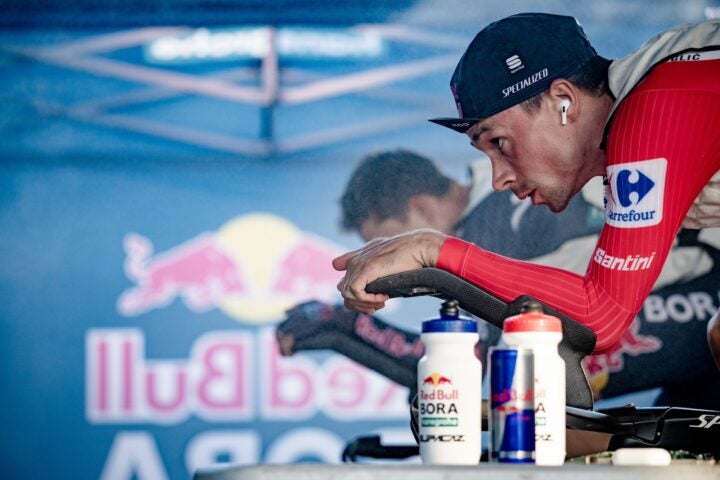 Teams are toying with the idea of using BFR within workouts. (Photo: Red Bull Content Pool)
Teams are toying with the idea of using BFR within workouts. (Photo: Red Bull Content Pool)
Performance-focused pressure cuff manufacturers could push BFR forward – if the peloton figures out how best to apply them.
Both Spragg of Tudor and Wemel of Quick-Step indicated they’re considering bringing some BFR into their training regime.
But both acknowledged that caution would be key in an experiment loaded with risk. Any explorations would likely begin at a very low intensity.
“Training is as much about what riders can recover from, rather than how far you can overload them. That’s why we haven’t gone down that path with BFR,” Spragg said. “We’re not looking to add extra stimulus on top. We can maximize that stimulus already with altitude or with heat or whatever else.”
Blood-restricted training is seen as the next frontier of this old-school protocol.
Rider buy-in, deeper research, and, probably also, UCI opinion, might be the deciding factors in this weird and wild world of BFR.
